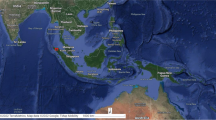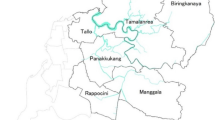Abstract
Prioritization of disaster risk was carried out for a community in Toronto, Canada. Geographic information systems (GIS) were used for spatial analysis, including spatial overlays and clipping for extracting spatial and attribute information related to people’s vulnerability, critical infrastructure and landuse. In order to determine disaster risk, the overall community vulnerability was evaluated by combining social, economic, physical and environmental vulnerabilities. This paper uses the propane explosion incident as the case in point to demonstrate the methodology and procedure used to evaluate risk using GIS techniques. City of Toronto spatial data have been integrated with the study area to gather landuse information, identify risk zones based on the propane storage facility location and evaluate risks. Statistics Canada 2006 census data have been used for area demographics and people’s social and economic status. Vulnerability indicators were determined based on the GIS-derived spatial and attribute data for the hazard and evacuation zones followed by a quantitative spatial risk estimation and ranking. The methodology of this study, based on the risk evaluation and prioritization conducted, can be applied to future decision making in effective landuse planning and the development of risk management strategies.




Similar content being viewed by others
References
Birk M, Katz S (2008) Report of the propane safety review. Ministry of Small Business and Consumer Services, Ontario, p 52
Carr MH, Zwick P (2005) Using GIS suitability analysis to identify potential future land use conflicts in North Central Florida. J Conserv Plan 1:58–73
Chakraborty J, Tobin GA, Montz BE (2005) Population evacuation: assessing spatial vulnerability in geophysical risk and social vulnerability to natural hazards. Nat Hazards Rev 6(1):23–33
Chang K (2008) Introduction to geographic information system. McGraw Hill, New York city, p 450
Church RL, Murray AT (2009) Business site selection, location analysis, and GIS. Wiley, Hoboken, NJ
CSA (2008) Z1600 emergency management and business continuity. Canadian Standards Association, Canada
Cutter S (ed) (1994) Isn’t any place safe anymore? Preface (page ix). In: Environmental risks and hazards. Prentice Hall.
Cutter SL, Mitchell JT (2000) Revealing the vulnerability of people and places: a case study of Georgetown County, South Carolina. Ann Am Geogr 90(4):713–737
EMO (2004) Provincial hazard identification and risk assessment. Emergency Management Ontario, Toronto
EMO (2010) Emergency management doctrine of Ontario. Emergency Management Ontario, Canada, p 40
FEMA (1993) Risk assessment approaches. Federal Emergency Management Agency, USA
Ferrier N, Haque E (2003) Hazards risk assessment methodology for emergency managers: a standardized framework for application. Nat Hazards 28:271–290
HIRA (2004) Provincial hazard identification and risk assessment, emergency management Ontario. Govt Ontario, Canada, p 23
ISDR (2004) Living with risk: a global review of disaster reduction initiatives, vol 1. UN International Strategy for Disaster Reduction publication, Switzerland, p 429. http://www.adrc.asia/publications/LWR/LWR_top.htm
Kar B, Hodgson ME (2008) A GIS-based model to determine site suitability of emergency evacuation shelters. Trans GIS 12(2):227–248
Kupcis L (2008) http://www.claimscanada.ca/issues/article.aspx?aid=1000224912 (Accessed May 19, 2011)
Lo CP, Yeung AKW (2007) Concepts and techniques of geographic information systems, 2nd edn. Pearson Prentice Hall, Upper Saddle River, New Jersey, p 532
Long MH, John JI (1993) Risk-based emergency response. Paper presented at the ER93 conference on the practical approach to hazardous substances accidents. St. John, New Brunswick, Canada
Martínez EV, López FC (2010) A cybercartographic tool for supporting disaster prevention planning processes and emergency management in Mexico City. In: Showalter PS, Lu Y (eds) Geospatial techniques in urban hazard and disaster analysis. Springer, Mexico City, pp 255–271
Mileti DS (1999) Disasters by design. Joseph Henry Press, Washington, DC
PEP (2004) Hazard, risk, and vulnerability analysis toolkit. Provincial Emergency Preparedness, British Columbia, Canada. http://www.pep.bc.ca/hrva/toolkit.html
Ponnambalam K, Nirupama N, Venema H (2001) Wetlands management using geographical information systems and multi-objective decision support system. In: James W (ed) Best modelling practices for urban water systems monograph 10. CHI Publications, Canada, pp 215–224
Puente R, Fernández I, Santa María JJO, Pérez Hernando MA, de Arróyabe Hernáez PF (2007) The development of a new methodology based on GIS and fuzzy logic to locate sustainable industrial areas. In: Proceedings of 10th AGILE International Conference on Geographic Information Science. Aalborg University, Denmark
Queen L (2009) Sunrise propane blast was test case for cleaning up asbestos. The Mirror, Friday, April 24, 2009
Sakellariou A, Katsios I, Magafosis A (2006) Multicriteria spatial decision support system: locating industrial zones with GIS. In: Proceedings of ESRI European User Conference
Slovic P (2000) The perception of risk, Earthscan Publications, London, p 473
Smith K (2004) Environmental hazards: assessing risk and reducing disaster. Routledge, London, p 306
Wilches-Chaux Gustavo (1993) La Vulnerabilidad Global. In: Maskrey Andrew (ed) Los desastres no san naturales. La Red, Colombia
Wisner B, Blaikie P, Cannon T, Davis I (2004) At risk: natural hazards. People’s Vulnerability and Disasters, Routledge 469p
Wojtasik R (2008) Pinpointing your environmental risks, environmental risk information service, ERIS Project No: 20081109001, p 16
Acknowledgments
The authors wish to express their gratitude to Trudy Bodak, Head, Maps and GIS Librarian, Map Library, York University, for her enthusiastic support in providing the data for the study. York University is also acknowledged for partially funding this work.
Author information
Authors and Affiliations
Corresponding author
Rights and permissions
About this article
Cite this article
Armenakis, C., Nirupama, N. Prioritization of disaster risk in a community using GIS. Nat Hazards 66, 15–29 (2013). https://doi.org/10.1007/s11069-012-0167-8
Received:
Accepted:
Published:
Issue Date:
DOI: https://doi.org/10.1007/s11069-012-0167-8




